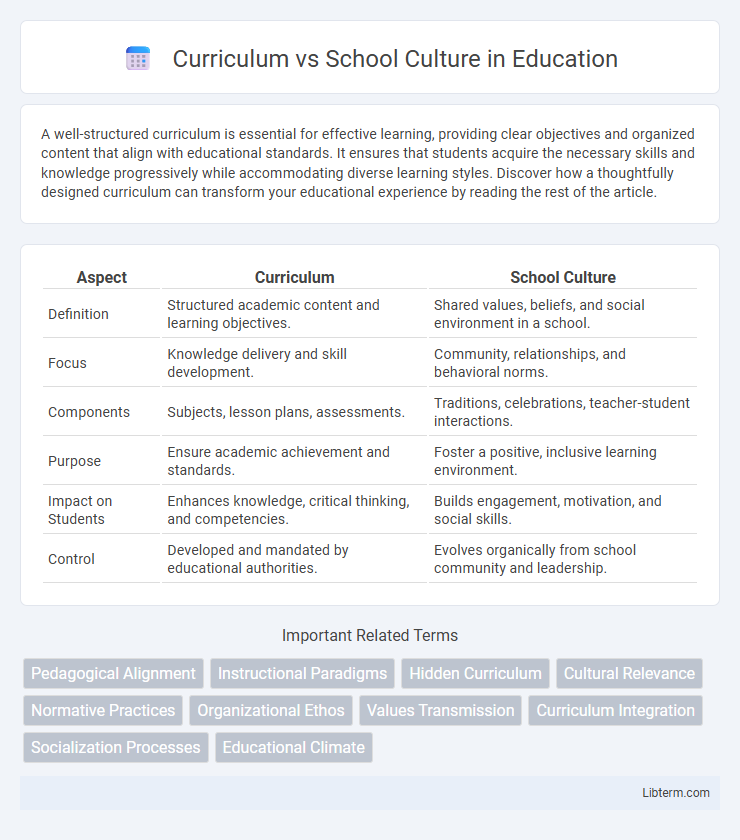A well-structured curriculum is essential for effective learning, providing clear objectives and organized content that align with educational standards. It ensures that students acquire the necessary skills and knowledge progressively while accommodating diverse learning styles. Discover how a thoughtfully designed curriculum can transform your educational experience by reading the rest of the article.
Table of Comparison
| Aspect | Curriculum | School Culture |
|---|---|---|
| Definition | Structured academic content and learning objectives. | Shared values, beliefs, and social environment in a school. |
| Focus | Knowledge delivery and skill development. | Community, relationships, and behavioral norms. |
| Components | Subjects, lesson plans, assessments. | Traditions, celebrations, teacher-student interactions. |
| Purpose | Ensure academic achievement and standards. | Foster a positive, inclusive learning environment. |
| Impact on Students | Enhances knowledge, critical thinking, and competencies. | Builds engagement, motivation, and social skills. |
| Control | Developed and mandated by educational authorities. | Evolves organically from school community and leadership. |
Understanding Curriculum: Definition and Purpose
Curriculum refers to the structured set of educational content, learning objectives, and assessment methods designed to guide teaching and student learning in schools. It serves the purpose of providing a coherent framework that ensures consistency in educational delivery, aligns with academic standards, and addresses the developmental needs of students. Unlike school culture, which encompasses the shared values, beliefs, and behaviors within a school community, curriculum specifically targets the knowledge and skills students are expected to acquire.
Defining School Culture: Core Elements
School culture encompasses the shared beliefs, values, and practices that shape the learning environment, distinct from the formal curriculum which outlines academic content. Core elements of school culture include interpersonal relationships, norms, rituals, and the overall climate that influences student engagement and teacher collaboration. Understanding these factors is essential for fostering a supportive atmosphere that enhances educational outcomes beyond curriculum delivery.
Curriculum and School Culture: Key Differences
Curriculum refers to the structured content and academic programs designed to guide student learning, including subjects, lesson plans, and assessment methods. School culture encompasses the shared values, beliefs, behaviors, and social environment that influence how students and staff interact within the school community. While curriculum shapes what students learn, school culture affects how they engage with the learning process and overall school experience.
The Interplay Between Curriculum and School Culture
The interplay between curriculum and school culture shapes student engagement and academic success by aligning instructional content with shared values and beliefs. A curriculum integrated with positive school culture fosters collaborative learning environments, promoting respect, motivation, and inclusivity. Tailored curricula reflecting the unique cultural context support meaningful connections, enhancing both teaching practices and student outcomes.
Impact of Curriculum on Student Outcomes
Curriculum design significantly influences student outcomes by shaping knowledge acquisition, critical thinking, and skill development, which directly correlate with academic achievement and long-term success. Research indicates that a well-structured and standards-aligned curriculum enhances cognitive engagement and promotes equity by providing consistent learning opportunities across diverse populations. Effective curriculum implementation drives measurable improvements in test scores, graduation rates, and college readiness, highlighting its pivotal role in educational effectiveness.
How School Culture Shapes Learning Experiences
School culture profoundly influences learning experiences by fostering an environment that supports student engagement, collaboration, and motivation, which extends beyond the formal curriculum. Positive school culture promotes inclusivity, respect, and shared values among students and staff, enhancing social-emotional development and academic achievement. Effective school culture integrates traditions, rituals, and relationships that create a sense of belonging and safety, directly impacting students' willingness to participate and thrive.
Aligning Curriculum with School Culture
Aligning curriculum with school culture enhances student engagement and academic success by reflecting shared values and community priorities in educational content. Embedding cultural norms and traditions into lesson plans fosters a sense of belonging and relevance, which supports deeper learning and behavioral alignment. Systematic collaboration between educators and stakeholders ensures the curriculum respects and reinforces the unique identity of the school environment.
Challenges in Harmonizing Curriculum and Culture
Conflicts between a standardized curriculum and diverse school cultures often arise, hindering effective learning and engagement. Teachers struggle to adapt rigid curricular frameworks to reflect community values and student identities, creating resistance or disengagement. Addressing these challenges requires flexible curriculum design that respects cultural nuances while maintaining academic standards.
Best Practices for Integrating Curriculum and School Culture
Aligning curriculum design with school culture enhances student engagement by embedding community values and traditions into lesson plans. Best practices include fostering collaboration among educators to create culturally relevant materials and promoting ongoing professional development that emphasizes diversity and inclusion. Integrating social-emotional learning within the curriculum also supports a positive school climate, reinforcing shared beliefs and norms.
Future Trends: Evolving Curriculum and School Culture
Future trends in education highlight a shift towards curricula integrating digital literacy, personalized learning, and social-emotional skills to prepare students for a rapidly changing world. School culture is evolving to emphasize inclusivity, mental health support, and community engagement, fostering environments that support diverse learner needs and well-being. The interplay between dynamic curricula and adaptive school culture drives innovation, resilience, and equity in educational outcomes.
Curriculum Infographic

 libterm.com
libterm.com